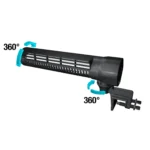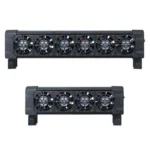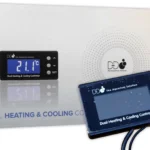Our summers here in the UK and around the world are getting hotter with record-high temperatures increasingly becoming the norm.
We all know the precautions we can take ourselves, like staying out of the sun at peak times and ensuring we are sufficiently hydrated.
We also know to keep our pets in a cool place with plenty of water to drink but what about our aquariums?
Certainly, in the UK, we know we need a heater to keep our temperature up for most of the year but what about during a heatwave? Can an aquarium get too hot for our tank inhabitants?
The answer, of course, is yes, too high a temperature in your aquarium can be fatal for your fish and other inhabitants.

Table of Contents
What is the Ideal Temperature Range for an Aquarium?
In general the ideal temperature range for tropical fish is between 75 and 80 °F(24 to 27 °C). This will vary depending on the species, of course, so you should make sure you know the ideal range for your particular fish.
Most fish can tolerate an increase in temperature slightly above this range for short periods provided it is not a rapid increase.
However, the problem is not so much the direct increase in temperature, but rather that an increase in water temperature, decreases the dissolved oxygen in the water and if this gets too low it can be fatal.
How to Keep Your Aquarium Cool
There are a number of things you can try to keep your aquarium cool during a hot spell and generally, a combination of these will be sufficient to ensure the safety of your tank inhabitants.
Avoid Direct Sunlight
You obviously can’t just move your aquarium so we hope that when you first set it up you did not place it where it will be in direct sunlight. If you had no choice, however, ensure that any direct sunlight is blocked from reaching your aquarium.
Do NOT Turn Off Your Heater
Whilst this may appear to be something you should be doing, it certainly isn’t.
All good heaters are thermostatically controlled and will turn themselves off when the required water temperature is reached, so during a hot spell it’s unlikely that your heater will come on at all.
Even during a hot spell, though, temperatures can still drop dramatically at night so you will need your heater to come on to keep your aquarium temperature stable.
So keep your heater on and let its thermostat do its job.
Better yet, use a temperature controller to maintain a stable temperature in your aquarium.
Lower Room Temperature
Unless you have air conditioning it may not be possible to lower the temperature of the room in which your aquarium is located but you can take steps to stop the temperature from getting too high.
- Open windows in the room and adjacent ones to try and create a ‘through draft’.
- Close curtains to prevent direct sunlight from entering any part of the room.
- Use fans to ensure good air circulation.
- Use air conditioning if you have it.
Increase Aeration
The biggest danger of your aquarium temperature being too high is this decreases the dissolved oxygen in the water.
Adding an air pump will help increase the aeration of the water.
For a saltwater tank ensure your skimmer is running efficiently as this also acts like an air pump.
Remove the Lid
This will increase evaporation allowing heat to escape from your aquarium. Be sure to have plenty of RO water on hand to top-off and maintain a steady water level in your tank.
Avoid this method though, if you have any fish that are likely to jump.
Turn the Lights Off
If you still run T5 or metal halide tubes that produce a lot of heat, running them for less hours or turning them off altogether may help.
This is less likely to be an issue with modern LED lighting so we would not expect too much to be gained from doing this if you have those.
Certainly, if you have a planted tank you should NOT do this. Plants produce oxygen during the day via photosynthesis and you don’t want to hamper this by turning the lights off.
Modify Feeding
You may wish to cut back on feeding. Nitrifying bacteria work best at temperatures from 25 – 30 degrees. Above this range, they become less efficient and less able to break down food and fish waste.
Water Changes
Provided your replacement water is 1 or 2 degrees lower than your aquarium water, a water change will help to bring your aquarium temperature down.
Don’t be tempted to do a larger water change than normal however as this may upset your tank parameters.
Also, never use cold water to perform a water change as the temperature shock could kill your fish and other inhabitants.
Use a Domestic Fan
Pointing a domestic fan directly at your tank or sump is a good way to lower water temperature. The air blowing from the fan will carry away the heat from the surface and increase evaporation removing heat from the water.
Be careful though if you use a normal domestic fan that it is in a stable position and not in any danger of falling into the tank.
Use an Ice Pack or Frozen Bottle
Floating an ice pack or frozen bottle of water in your aquarium or sump should only be used in emergencies.
If you have poor flow in your tank you will only create a localised cold spot in your tank which will be very cold for any fish that venture near. So cold that the shock could kill them.
Only use this method with extreme care if you have exceptional flow in your tank or have a saltwater tank with a large sump in which you can place the ice pack or frozen bottle of water.
Use an Aquarium Cooling Fan
Short of buying a chiller, which can cost hundreds of pounds, the best way to cool your aquarium is by using a dedicated aquarium cooling fan.
These fans clamp firmly to the side of your aquarium or sump and work by blowing air across the surface. Due to the airflow, the warm water evaporates at the water surface and thus generates evaporative cooling.
We recommend the fans below from JBL:-
 | JBL Protemp Cooler Fan x200 / 60 – 200 Litres x300 / 90 – 300 Litres. | Check pricing on eBay >> *Free UK Delivery |
To automatically control the JBL Protemp Cooler fans we recommend:-
 | JBL Protemp Controller | Check pricing on eBay >> *Free UK Delivery |
Or you may wish to take a look at the fans from D-D Ocean:-
 | D-D Ocean Breeze Cooling Fan | Check pricing on eBay >> *Free UK Delivery |
To automatically control the D-D Ocean Breeze Cooling Fan we recommend:-
 | D-D Temperature Controller | Check pricing on eBay >> *Free UK Delivery |
Keeping Your Aquarium Cool FAQs
What temp is too hot for a fish tank? – The best temperature range for tropical fish is between 75 and 80 °F(24 to 27 °C) but this will vary depending on the species.
Most fish can tolerate a temperature 1 or 2 degrees above that but beyond that, they will become stressed and may die.
What happens when fish overheat? – Initially, fish will become stressed but as the temperature rises higher the oxygen levels in the water become depleted and the fish may die of oxygen starvation.
How do I reduce the heat in my aquarium? – First, avoid direct sunlight from hitting your aquarium. Then lower the room’s temperature by opening windows or adding a fan.
Remove the tank lid and point a fan directly at the surface or get a good aquarium cooling fan.
You should, also, always use a temperature controller for your heaters to ensure they are turned off at the correct temperature.
